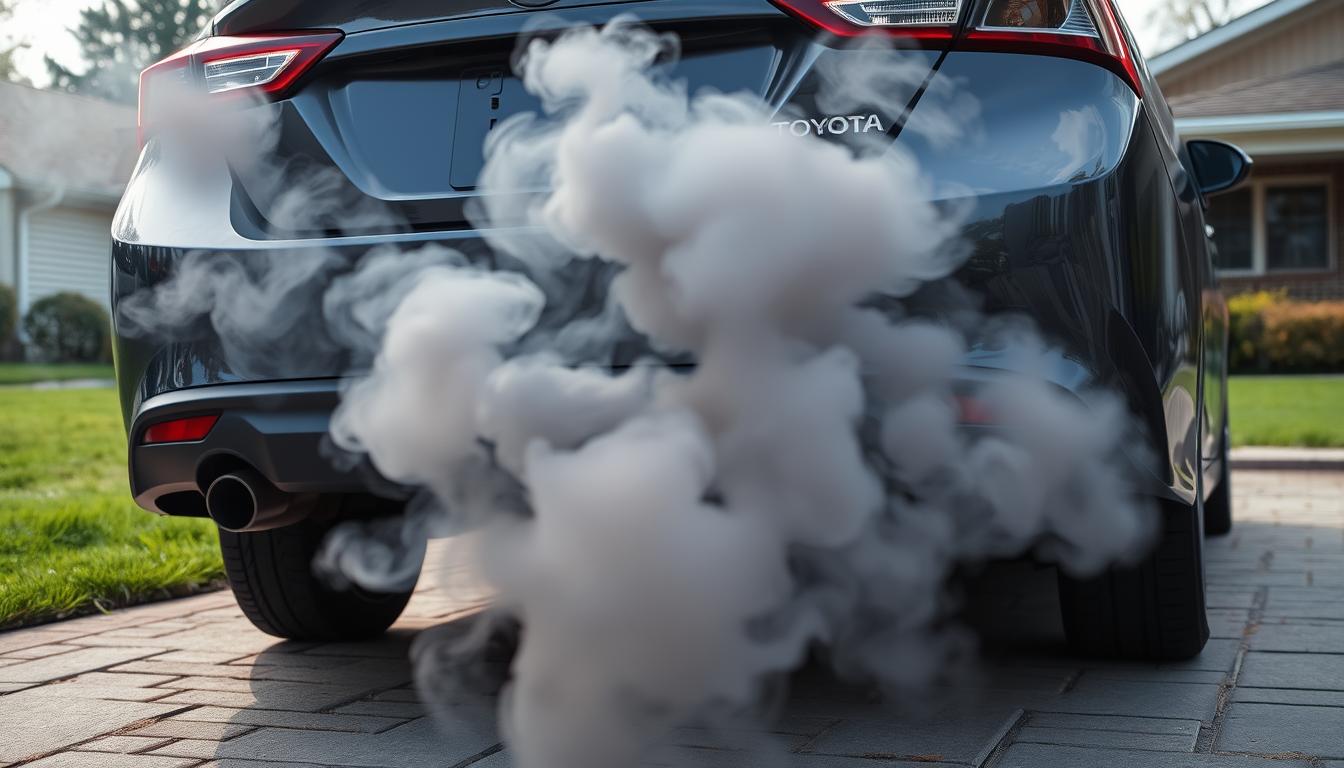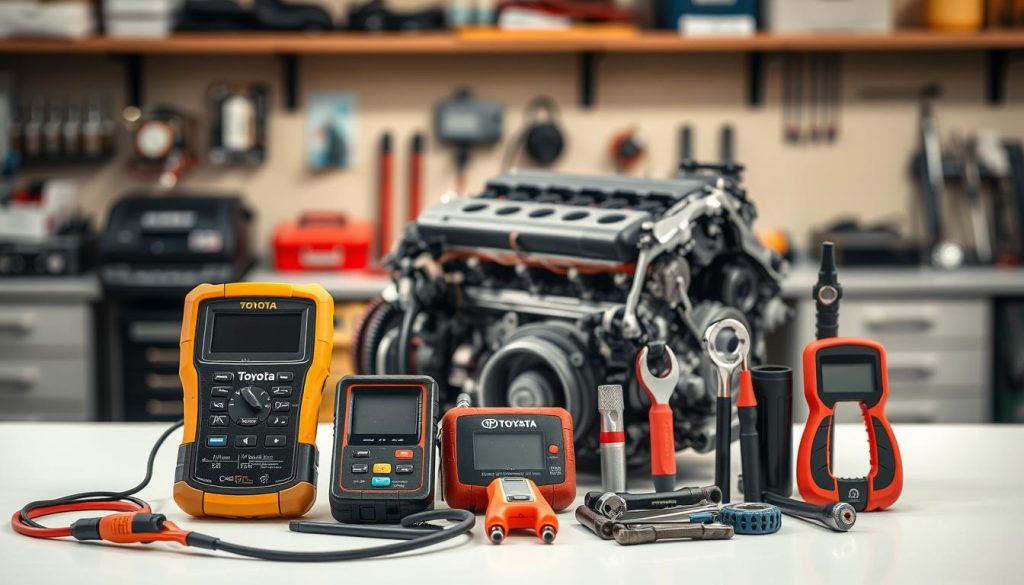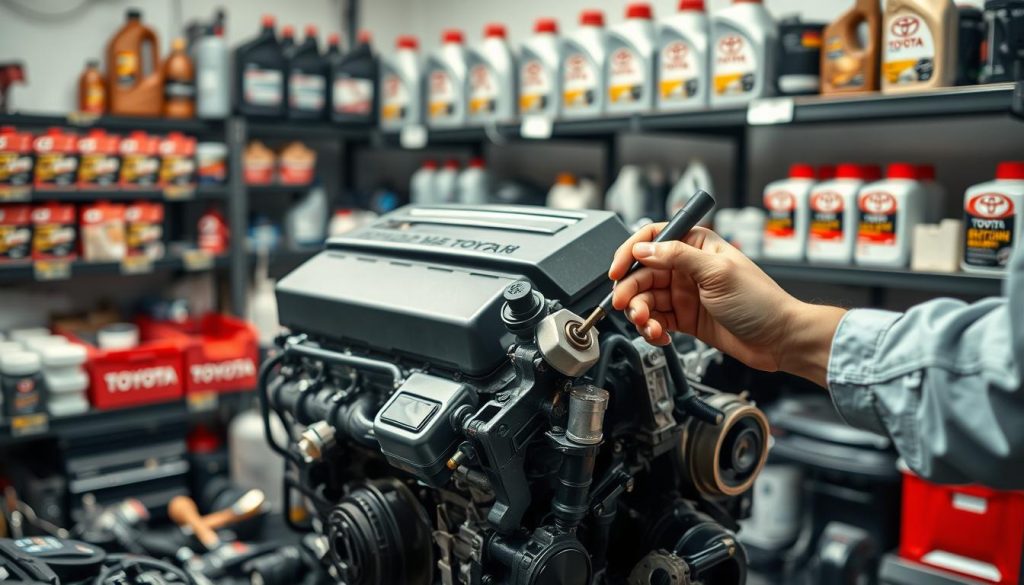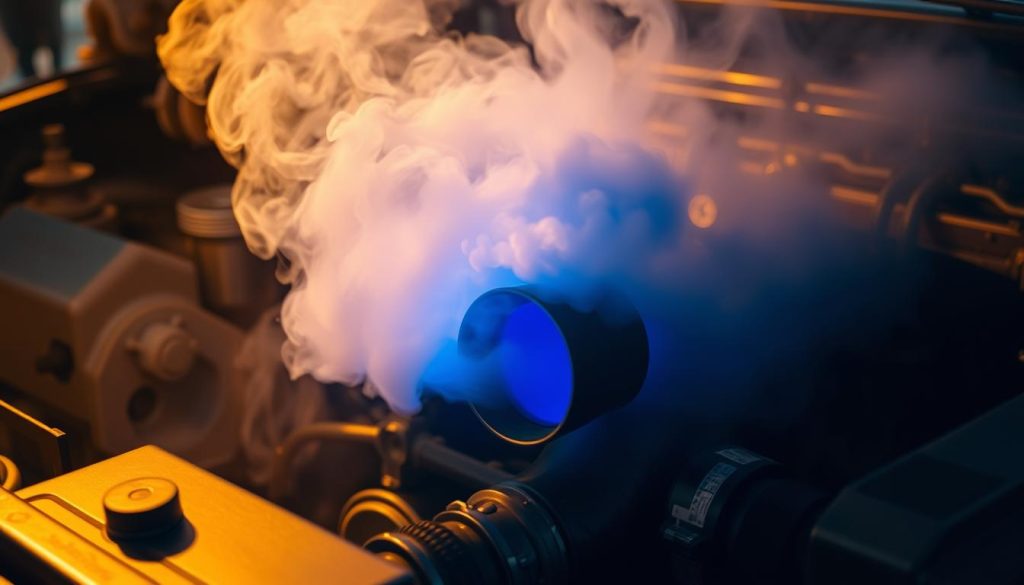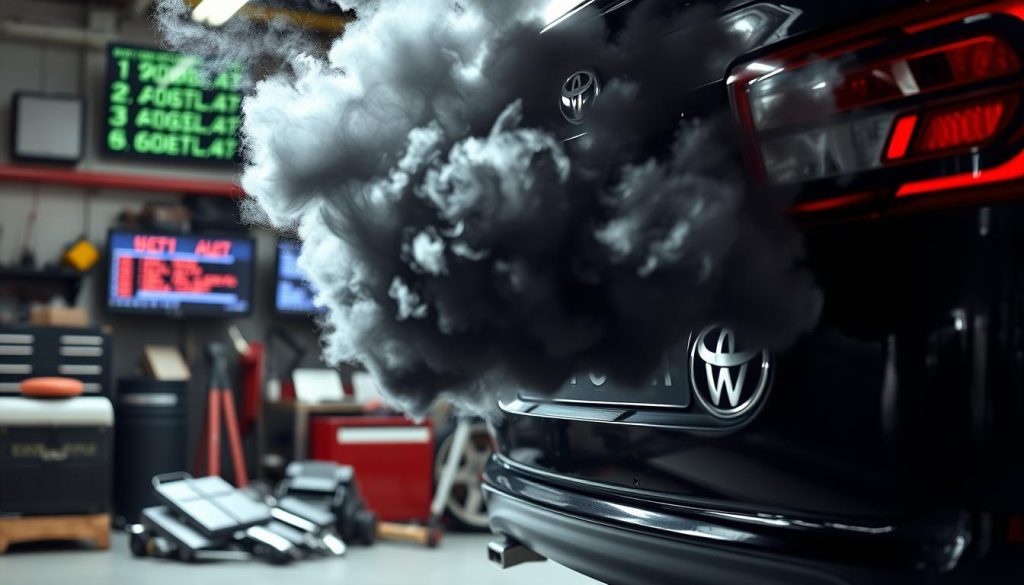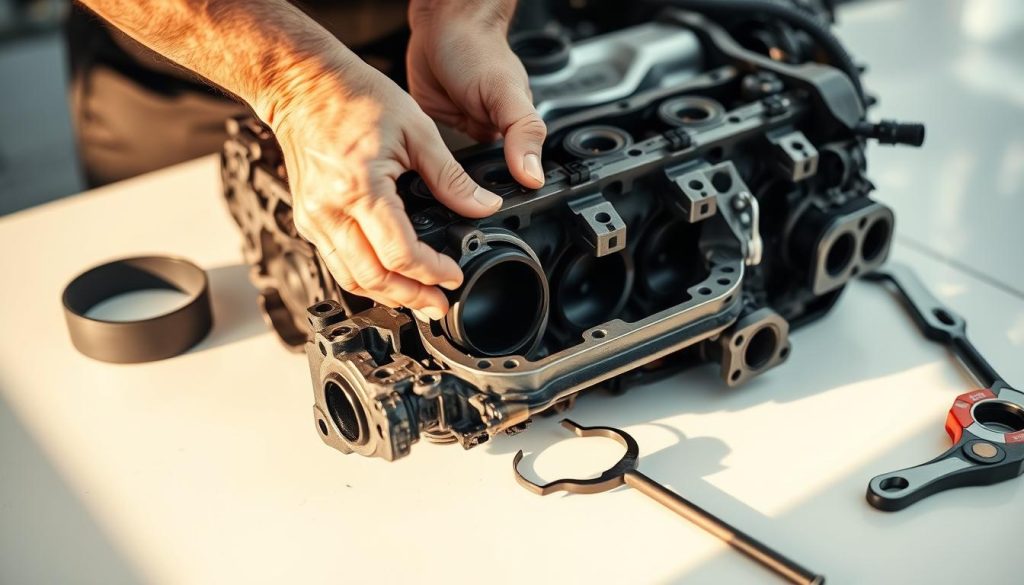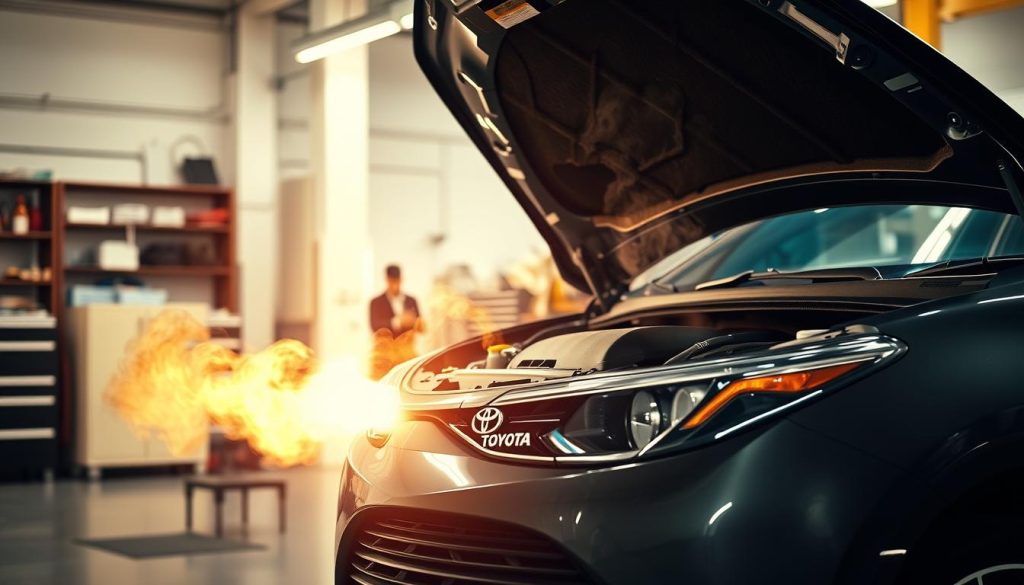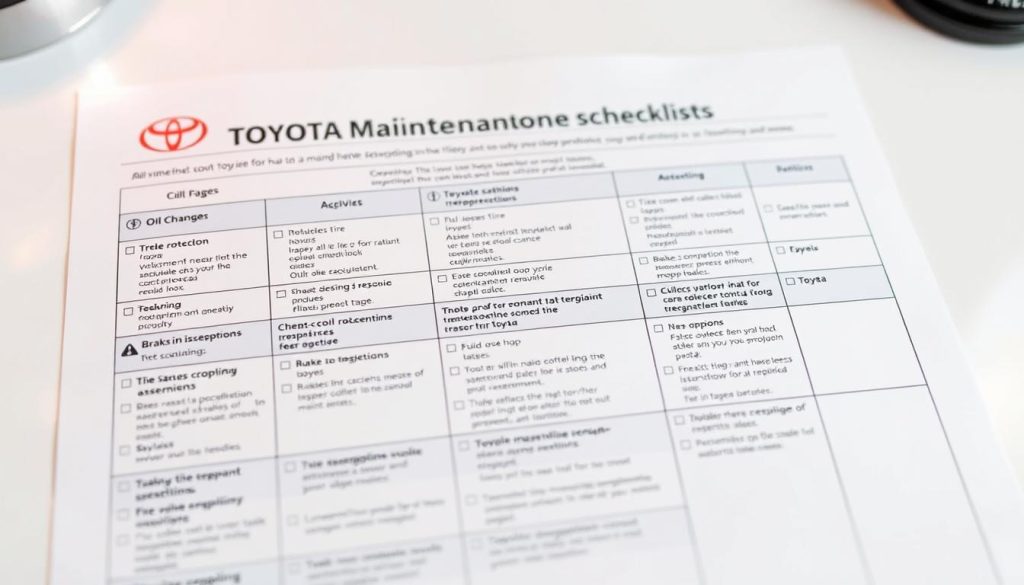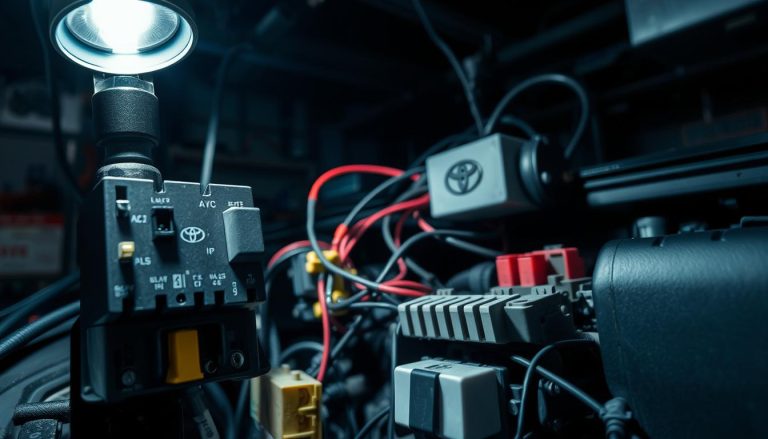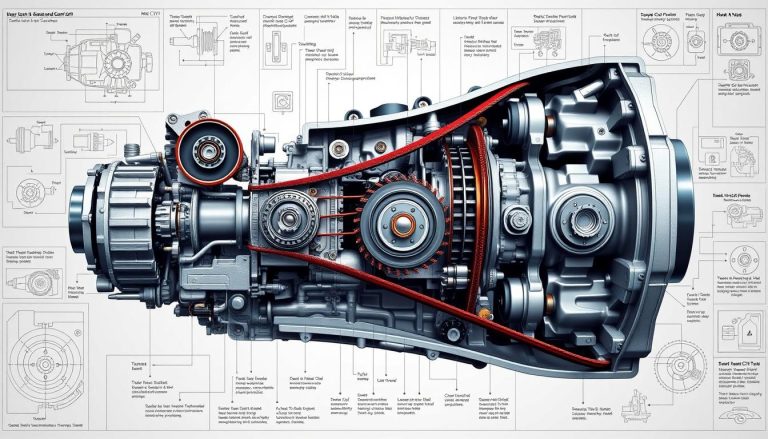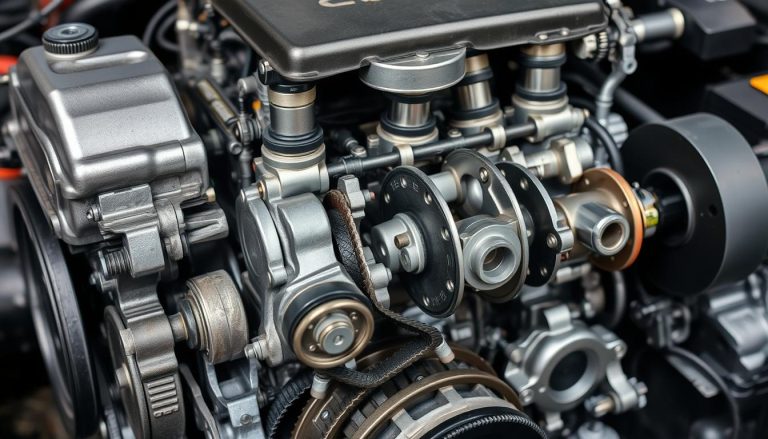Understanding and Fixing Toyota Smoking Exhaust
Seeing smoke from your car’s tailpipe means something’s off. This exhaust smoke diagnosis can tell you a lot about your car’s health. Each color of smoke has its own story to tell about what’s going on inside.
Dark smoke when you accelerate, blue puffs when you start, or constant white smoke all mean something’s wrong. These issues can make your car run poorly and waste fuel. They might even cause you to fail emissions tests.
This detailed Toyota repair guide will show you how to find and fix your car’s smoking problems. We’ll go over how to diagnose and fix these issues step by step. No matter if it’s white, blue, or black smoke, knowing what’s wrong is the first step to fixing it.
We focus on preventive measures to keep your car running well. We’ll teach you how to avoid expensive engine damage and keep your car eco-friendly.
Key Takeaways
- Different smoke colors indicate specific engine or system problems that require targeted solutions
- Early diagnosis prevents costly engine damage and maintains vehicle performance
- Proper identification of root causes leads to more effective and lasting repairs
- Regular maintenance helps prevent most exhaust smoke issues from developing
- Understanding diagnostic procedures empowers car owners to make informed repair decisions
- Addressing smoke problems promptly ensures compliance with emissions standards
Identifying Different Types of Exhaust Smoke in Your Toyota
Your Toyota’s exhaust smoke color is a clue to engine problems. Knowing the exhaust smoke types helps you spot issues fast. Each color means different engine problems that need different fixes.
When smoke shows up is key to diagnosing. Some smoke is only seen when starting cold, while others last all drive. Knowing these patterns helps you talk to mechanics and make smart repair choices.
| Smoke Color | Primary Cause | Typical Timing | Repair Urgency |
|---|---|---|---|
| White | Coolant burning | Continuous during operation | High – Engine damage risk |
| Blue | Oil consumption | Startup and acceleration | Medium – Progressive wear |
| Black | Rich fuel mixture | Heavy acceleration | Low – Performance impact |
White Smoke Characteristics and Timing
White smoke is thick and looks like steam. It means coolant is getting into the combustion chamber. This can be due to damaged head gaskets or cracked engine parts.
White smoke is most visible when the engine is warming up. Unlike normal steam, this smoke stays and smells sweet from burning coolant.
Blue Smoke Appearance and Patterns
Blue smoke looks oily and shows up in certain driving situations. A blue smoke engine burns oil because of worn parts like valve seals or piston rings. It’s most noticeable when starting the car after it’s been parked overnight.
Blue smoke also appears during hard acceleration. This is because the engine’s pressure forces oil past worn seals. The smell of burning oil is a giveaway.
Black Smoke Density and Conditions
Black smoke is dense and sooty, showing an engine is getting too much fuel. Black smoke diagnosis points to air intake issues, faulty fuel injectors, or engine sensors. These problems affect the fuel-to-air ratio.
Black smoke is most common during acceleration. It’s caused by clogged air filters, faulty mass airflow sensors, or dirty fuel injectors.
Essential Tools and Safety Preparation for Diagnosis
Having the right diagnostic tools and following safety steps is key. It ensures accurate diagnosis and keeps you safe when fixing Toyota smoking exhaust issues. Being prepared saves time and avoids costly errors during troubleshooting. You need the right tools before starting any engine diagnosis work.
Required Diagnostic Equipment
Professional Toyota maintenance tools are vital. They help you know what’s wrong with your engine. A compression tester finds internal engine problems that cause blue smoke. A coolant system pressure tester detects head gasket failures, leading to white smoke.
Digital multimeters and OBD-II scanners show sensor issues and error codes. These diagnostic tools help find fuel system problems that cause black smoke. Basic hand tools, vacuum gauges, and oil analysis kits are also essential.
Safety Precautions and Protective Gear
Wearing safety equipment keeps you safe from hot engine parts and harmful fluids. Always work on a cool engine to avoid burns. Wear protective eyewear and chemical-resistant gloves when handling engine fluids.
Make sure there’s good air flow when running the engine. Keep a fire extinguisher close when working with fuel systems. Use proper jack stands when lifting the vehicle for undercarriage checks.
| Equipment Category | Essential Items | Safety Purpose | Cost Range |
|---|---|---|---|
| Testing Tools | Compression tester, OBD-II scanner | Accurate engine diagnosis | $50-$200 |
| Protective Gear | Safety glasses, gloves, coveralls | Personal protection | $20-$60 |
| Safety Equipment | Fire extinguisher, jack stands | Emergency protection | $40-$100 |
| Hand Tools | Wrenches, screwdrivers, pliers | Component access | $30-$80 |
Step 1: Performing Initial Toyota Exhaust Smoke Assessment
Your Toyota’s exhaust smoke tells a story about its engine health. This exhaust smoke assessment is your first clue to problems. It helps spot issues before they cost a lot to fix. Start by noting the smoke’s color, thickness, and any smells it has under different conditions.
Keep a record of what you see. Take photos or videos to track changes. Note the smoke’s color, how thick it is, and any smells it has.
Cold Start vs Warm Engine Smoke Analysis
Cold start diagnosis shows engine problems clearly. Blue smoke right away means valve seal issues. This smoke should get less as the engine warms up.
White smoke in cold weather might be normal water vapor. But thick white smoke that lasts means coolant is burning. Sweet-smelling white smoke points to coolant system issues.
Compare cold start to warm engine performance. Smoke that only shows up when cold means seal problems. Smoke that keeps showing up, no matter the temperature, means serious wear inside.
Smoke Duration and Intensity Evaluation
Watch how long smoke lasts. Normal condensation should go away in five minutes. Smoke that lasts longer needs quick attention.
Rate smoke intensity from light to thick. Light blue smoke when speeding up might mean a little oil is being used. But thick black smoke means serious fuel system issues.
See how smoke changes with engine RPM. Note if smoke gets worse when speeding up, idling, or slowing down.
Driving Condition Smoke Patterns
Test your Toyota in different driving situations to find smoke patterns. Each situation stresses different engine parts.
Black smoke when speeding up often means fuel mix or air filter problems. Blue smoke when slowing down suggests worn valve guides or seals.
Write down when smoke is most noticeable. This helps mechanics focus and saves you time and money.
Step 2: Checking Engine Fluids and Levels
Engine fluid analysis is key to understanding your Toyota’s health. It helps find out if dirty fluids are causing smoke. Proper fluid inspection can solve problems before you spend a lot on repairs.
Start by letting the engine cool down and park on level ground. This makes sure your readings are right and keeps you safe from burns. Wait at least five minutes after turning off the engine for the fluids to settle.
Oil Level and Quality Inspection
First, remove the dipstick and clean it with a lint-free cloth. Put it back in and pull it out to check the oil level and color. Fresh oil is amber or black. If it’s dirty or has unusual colors, it’s not good.
Watch for signs like milky oil, which means coolant is leaking. Metal particles mean engine wear. And if the oil looks thick and tar-like, it’s time for a change to avoid smoke.
Coolant System Examination
Check the coolant level in the radiator and overflow when it’s cool. Normal coolant is bright green, orange, or pink. Oil in the coolant makes it look rainbowy.
If the coolant is low and you don’t see leaks, it’s being used up inside. This could mean a bad head gasket or cracked engine parts, causing white smoke.
Transmission Fluid Assessment
Look at the transmission fluid when the engine is running and the transmission is warm. Clean fluid is bright red. Burnt fluid is dark brown or black and can cause smoke.
Keep a record of your findings for Toyota maintenance:
| Fluid Type | Normal Condition | Warning Signs | Potential Cause |
|---|---|---|---|
| Engine Oil | Amber to black, smooth texture | Milky appearance, metal particles | Coolant leak, internal wear |
| Coolant | Bright color, clear consistency | Oil contamination, low level | Head gasket failure |
| Transmission Fluid | Bright red, clean smell | Dark brown, burnt odor | Overheating, component wear |
| Power Steering | Clear red or amber | Foamy, contaminated | Air in system, leaks |
Step 3: Diagnosing White Smoke Causes in Toyota Engines
White smoke from your Toyota’s exhaust means you need to find out why coolant is getting into the combustion chamber. This is a serious issue that can lead to expensive repairs if not fixed quickly. Knowing how to diagnose the problem helps you find where the coolant is leaking into your engine.
Fixing white smoke starts with finding the exact cause. This involves using different tests to check your Toyota’s cooling system. It’s important to follow a step-by-step approach to avoid guessing and focus on the most likely problems.
Head Gasket Failure Detection Methods
Head gasket failure is a common reason for white smoke in Toyota engines. Start by using a combustion gas test. This test changes color when exhaust gases mix with the cooling system. It shows if combustion gases are getting into your coolant.
Next, do a cooling system pressure test to find internal leaks. If the pressure drops, it means the head gasket is failing. Also, look for bubbles in the radiator when the engine is running. This shows that combustion gases are mixing with the coolant.
Check your oil for coolant by looking at the dipstick and oil filler cap. If it looks milky or foamy, coolant is mixing with the oil. Keep an eye on the engine temperature. Head gasket failure can cause it to overheat quickly or fluctuate strangely.
Coolant Leak Identification Techniques
Diagnosing coolant leaks goes beyond just checking the head gasket. Remove spark plugs to see if they’re clean or look like they’ve been steam cleaned. This shows if coolant is washing the combustion chambers. It can also tell you which cylinders are affected.
Do cylinder compression tests to find out which areas have problems. Take note of the compression readings for each cylinder. This helps you see if it’s just one cylinder or more that’s affected.
Intake Manifold Problem Diagnosis
Intake manifold problems can also cause white smoke if coolant leaks into the intake ports. Look for coolant seepage around where the intake manifold meets the engine block. Check for dried coolant residue or active leaks in these areas.
Do vacuum tests to find internal leaks in the intake manifold. Pay attention to how the engine idles. If it’s rough and there’s white smoke, it might be intake manifold problems. Sometimes, you need professional testing to figure out what’s going on when symptoms overlap.
| Diagnostic Method | Purpose | Expected Results | Time Required |
|---|---|---|---|
| Combustion Gas Test | Detect exhaust gases in coolant | Color change indicates failure | 15 minutes |
| Pressure Test | Find internal coolant leaks | Pressure drop shows leak location | 30 minutes |
| Compression Test | Identify affected cylinders | Low readings indicate problems | 45 minutes |
| Visual Inspection | Check spark plugs and gaskets | Clean plugs show coolant washing | 20 minutes |
Step 4: Identifying Blue Smoke Sources and Engine Wear
Blue smoke from your Toyota’s exhaust means oil is burning in the engine. It’s important to find out where the problem is. This smoke happens when parts inside the engine fail, letting oil get into the combustion chambers.
Knowing blue smoke causes helps you fix things fast and avoid expensive engine damage.
To find the problem, you need to test different parts that control oil flow. Each part is key to stopping oil consumption. Knowing which parts need fixing helps you plan repairs and save money.
Ring and Cylinder Wear Testing
First, do compression and leak-down tests on each cylinder. These tests show if piston ring wear or cylinder walls are damaged. Normal readings should be close to each other in all cylinders.
If compression is low and leak-down is high, it means rings or walls are worn out. Watch your oil consumption over 1,000 miles. More than one quart used means serious wear that needs fixing right away.
Look at spark plugs for oil fouling. Wet, black deposits mean oil is getting into the combustion chambers through bad seals.
Valve Seal Condition Assessment
Watch how smoke moves when the engine is running to check valve seals. Smoke mostly during start-up or after long idling means valve seal problems. You’ll need to replace the valve seals.
Remove the oil filler cap while the engine is running. Look for high pressure or oil mist. This means rings are worn, letting gases past the seals.
A well-working engine should have little pressure at the oil filler opening during normal use.
PCV System Functionality Check
Check your PCV system by removing the PCV valve and shaking it. A good valve rattles. Look for cracks or blockages in PCV hoses that cause pressure and oil leaks.
Do a vacuum test at the PCV valve. It should draw consistently while the engine is running. A bad or blocked PCV system can pull oil into the intake, causing blue smoke.
| Test Method | Normal Results | Problem Indicators | Required Action |
|---|---|---|---|
| Compression Test | Within 10% variance | Low readings, high variance | Ring or valve repair |
| Oil Consumption | Less than 1 qt/1000 miles | Excessive usage rates | Internal seal replacement |
| PCV Valve Test | Rattles when shaken | No rattle, stuck open/closed | Valve replacement needed |
| Blow-by Check | Minimal pressure at filler | Excessive pressure, oil mist | Ring replacement required |
Step 5: Determining Black Smoke and Fuel System Issues
Black smoke from your Toyota’s exhaust means there’s a fuel system imbalance. This rich mixture condition happens when your engine gets too much fuel or not enough air. Knowing these black smoke causes helps you find the right parts to check.
The diagnostic process looks at three key areas. These areas work together to ensure your engine burns fuel correctly. Each system affects how fuel and air mix in your Toyota’s engine.
Air Intake System Inspection
Begin by checking the air filter’s condition. A dirty filter limits airflow, making the engine use more fuel. Look for oil, debris, or damage that might need air filter replacement.
Also, check all intake ducts for cracks or loose parts. Air leaks confuse your Toyota’s sensors, leading to wrong fuel calculations. Make sure the mass airflow sensor and its tubes are okay.
“A clogged air filter can reduce engine efficiency by up to 10% and significantly increase fuel consumption.”
Fuel Injector Performance Testing
Listen for injector clicks when the engine runs. Weak or irregular sounds mean fuel injector problems that cause uneven fuel distribution. Use a gauge to check fuel rail pressure if you have one.
Try using injector cleaner first. It can fix minor clogs without the cost of new injectors. Watch for smoke reduction when accelerating after treatment.
Engine Sensor Diagnostic Procedures
Scan for codes related to fuel system sensors. The oxygen sensor is key for mixture control, and throttle position sensors affect fuel delivery timing.
Test sensor voltages under different engine conditions. Faulty sensors stop the engine from adjusting fuel mixtures right, leading to black smoke. Replace sensors with odd readings or slow responses.
Keep detailed records of your findings. Many factors can cause black smoke in Toyota vehicles.
Fixing White Smoke Problems in Toyota Vehicles
White smoke in Toyota vehicles needs quick action to avoid engine damage. These fixes often require big engine work. But, doing it right ensures a lasting fix. Professional-grade repairs find and fix the real problem, not just cover it up.
Most white smoke problems come from three main areas. Each needs its own repair method. Knowing this helps pick the best fix for your Toyota.
Head Gasket Replacement Process
Head gasket replacement is the most challenging fix for Toyota engines. It involves removing the cylinder head and following strict specs. Start by draining all engine fluids and taking out parts that get in the way of the cylinder head bolts.
Use a straightedge to check if the head and block are warped. If they’re not right, you might need to machine them. Clean the gasket surfaces well, making sure not to harm the aluminum.
Put in new head gaskets, following the exact tightening steps and specs. It’s a multi-step process with specific angles. Think about replacing other parts like thermostats and water pumps too. This can make the repair even better.
Coolant System Repair Procedures
Coolant system repair is more than just replacing parts. It includes flushing the system and checking the pressure. Replace any old coolant hoses, as fixing the head gasket puts stress on the cooling system. Also, install new radiator and heater core caps for the best results.
It’s important to bleed the system correctly after repairs. Air pockets can cause overheating and damage the new gaskets. Use the right coolant mix and follow the recommended service schedule for the best outcome.
- Flush the cooling system completely
- Replace any old hoses and clamps
- Test the system pressure thoroughly
- Bleed air pockets carefully
Intake Manifold Gasket Replacement
Intake manifold gasket replacement is a less complicated fix for some white smoke issues. Take out the intake parts carefully, marking where vacuum lines go. Clean the intake ports and manifold, checking for any damage or warping.
Use sealers only where Toyota says to. Too much sealant can block passages or mess up the intake system. Test everything well with long drives under different conditions.
Watch the coolant levels closely for the first 500 miles after fixing white smoke. New gaskets might need some adjustments. Keep detailed records of all work done for warranty claims and future service needs.
Repairing Blue Toyota Smoking Exhaust Issues
Blue smoke from your Toyota’s exhaust means you have oil consumption problems. These issues come from worn-out parts that let engine oil get into the combustion chamber. The repair needed depends on which parts are damaged.
To fix the blue smoke fix, you need to find out which parts are the problem. This could be valve seals, piston rings, or parts of the PCV system. Each part needs different skills and tools to fix, so finding the right one is key.
Replacing Worn Valve Seals
Valve seal replacement can be done without taking the engine apart. You’ll need special tools to compress the springs. Remove spark plugs and use compressed air to keep the valves up during the repair.
Work on one cylinder at a time. Compress the springs and take out the old seals. Use the right tools to put in new seals without damaging them. Replace all valve seals at once to avoid future oil problems.
Clean the valve stems and guides well. Too much carbon buildup can cause seals to fail early and ruin your repair.
Engine Piston Ring Repairs
Piston ring repair needs the engine to be taken apart and often requires a machine shop. You’ll need to hone the cylinders and measure the ring gaps carefully.
Think about using better aftermarket rings for longer life, even more so in high-mileage engines. Sometimes, rebuilding the engine is cheaper than just fixing the rings if many parts are worn.
Knowing how piston ring repair works helps you understand repair quotes better. It helps you decide what’s best for your Toyota.
PCV System Component Service
PCV system repair is a good DIY fix for blue smoke. Replace the whole PCV system, not just parts.
Clean the intake manifold and throttle body where oil vapors collect. Make sure the vacuum works right after fixing it, as wrong vacuum means blockages or bad installation.
Today’s Toyota PCV systems have many parts and sensors. You need to test them right. Watch oil consumption for a few thousand miles after fixing it. New parts need time to work well.
Resolving Black Smoke and Performance Problems
Fixing black smoke in Toyota vehicles means fixing fuel and air imbalances. These fixes are often cheaper than other exhaust smoke repairs. Black smoke repair aims to get the air-fuel mix right by keeping parts clean.
Most black smoke comes from dirty air filters, clogged fuel injectors, or bad sensors. These block your engine from getting the right fuel and air mix. Luckily, fixing these is easy and won’t break the bank.
Cleaning Your Air Filter and Intake System
Air filter replacement starts with taking out and checking the filter. Replace it if it’s dirty or damaged. Clean filters help your engine breathe better.
Also, clean out the air filter housing and intake ducts. Make sure all connections are tight to keep air out. Think about getting better filters for better engine performance.
Servicing and Replacing Fuel Injectors
Fuel injector cleaning begins with fuel system cleaners in your gas tank. Use them as directed to keep injectors clear. These cleaners help with minor clogs.
For big clogs, ultrasonic cleaning is needed. This method tests and cleans each injector. Make sure new injectors fit perfectly and replace seals to avoid leaks.
Repairing Mass Airflow and Oxygen Sensors
Mass airflow sensor cleaning needs care because of its sensitive parts. Use only approved cleaners and avoid touching wires. Clean sensors help your engine computer get accurate readings.
Oxygen sensor replacement starts with checking if it’s really broken. Use a multimeter to test it against Toyota’s standards. Replace both sensors for best results. Reset your engine computer after to adjust properly.
Repair Cost Breakdown for Toyota Exhaust Smoke Issues
Fixing a smoking exhaust on a Toyota can cost a lot, depending on the problem and how you fix it. Knowing these costs helps you plan your budget and make smart choices for your car’s care.
Parts and Materials Expenses
The price of parts changes a lot, based on your specific issue. For simple fixes like replacing the air filter, you might spend $15-30. But, more complex repairs can cost a lot more.
Fixing a head gasket can cost between $200-800, depending on your engine and what you choose. Replacing valve seals costs $100-300, and piston ring sets are $150-400.
Other materials can add 10-20% to your total cost. This includes things like gasket sealers, coolant, oil, and other parts. OEM Toyota parts are pricier but ensure your car works right and are covered by warranty.
Labor Costs and Time Estimates
How much you pay for professional help depends on the repair. Replacing an air filter takes 15-30 minutes and costs $100-150 an hour.
Replacing a head gasket takes 8-12 hours of work, making it very expensive. Valve seal replacement takes 4-6 hours, and fuel injector service is 2-4 hours.
Where you live also affects how much you pay. Cities usually charge 20-40% more than rural areas for the same work.
DIY vs Professional Service Comparison
Doing it yourself can save money if you know what you’re doing. Simple tasks like air filter and PCV valve replacement are good DIY projects with little risk.
But, complex jobs like fixing a head gasket need special tools and skills. Think about your skills, time, and the risks of mistakes when deciding between DIY and hiring a pro.
Preventing Future Toyota Exhaust Smoking Problems
Smart Toyota owners know that preventing exhaust smoking issues saves money and extends engine life. Preventive maintenance costs far less than major engine repairs and keeps your vehicle running smoothly for years. Taking a proactive approach protects your investment and ensures reliable transportation.
The foundation of exhaust smoke prevention lies in consistent care and attention to your vehicle’s needs. Regular inspections and timely service prevent small problems from becoming expensive repairs.
Scheduled Service Intervals
Following your Toyota maintenance schedule prevents most exhaust smoking problems before they start. Your owner’s manual contains specific service intervals designed to keep your engine healthy. These schedules account for normal driving conditions and component wear patterns.
Severe driving conditions require more frequent service. Stop-and-go traffic, extreme temperatures, and dusty environments accelerate wear. Adjust your maintenance schedule to protect your engine.
| Service Item | Normal Conditions | Severe Conditions | Benefits |
|---|---|---|---|
| Oil Changes | 7,500 miles | 5,000 miles | Prevents engine wear |
| Air Filter | 15,000 miles | 12,000 miles | Maintains proper air flow |
| Coolant Service | 100,000 miles | 75,000 miles | Prevents overheating |
| PCV System | 30,000 miles | 20,000 miles | Reduces oil consumption |
Premium Fluids and Components
Using quality motor oil and genuine filters significantly impacts engine longevity. Cheap fluids may save money upfront but often cause expensive problems later. Toyota-approved specifications ensure compatibility and optimal protection.
Synthetic oils offer superior high-temperature stability and extended drain intervals. They resist breakdown under extreme conditions and provide better engine protection than conventional oils.
An ounce of prevention is worth a pound of cure.
Monitoring and Detection
Early problem detection catches issues before they cause visible exhaust smoke. Monthly visual inspections reveal developing problems like fluid leaks or worn components. Check oil and coolant levels regularly between service intervals.
Pay attention to performance changes that signal trouble. Rough idle, unusual noises, or decreased fuel economy often precede smoking exhaust. Address these warning signs promptly to prevent costly repairs.
Document all maintenance activities in a service log. This record helps identify patterns and ensures nothing gets overlooked during routine care.
When Professional Help is Necessary for Your Toyota
Some engine problems are too hard for DIY fixes and need professional Toyota service. Issues like smoking exhaust often involve parts inside the engine. These parts need special tools and skills to fix.
Major Internal Engine Work
An engine rebuild is needed when many parts fail at once. This includes worn piston rings, damaged cylinders, or cracked engine blocks. These complex repairs need precise tools and follow factory specs.
Professional shops have the right tools and Toyota’s technical guides. They can do things like cylinder boring and valve seat machining. DIY mechanics usually don’t have these tools.
Coverage and Financial Protection
Warranty considerations are key when deciding on repairs. New Toyotas might have coverage for defects causing smoke. Extended warranties need repairs from authorized shops.
Keep detailed records of symptoms and maintenance. Insurance might need a professional diagnosis report. Some policies cover damage from outside causes or mechanical failures.
Finding the Right Repair Shop
Choosing the right Toyota technicians is important. Look for ASE-certified mechanics with Toyota training. Check reviews and ask about warranties.
Get detailed estimates before starting work. Compare costs and expertise between dealerships and independent shops. Make sure they use genuine Toyota parts and have the latest tech info.
| Service Type | Best For | Average Cost | Warranty Period |
|---|---|---|---|
| Toyota Dealership | Warranty repairs | $150-200/hour | 12-24 months |
| Independent Shop | Out-of-warranty vehicles | $100-140/hour | 6-12 months |
| Engine Rebuild Specialist | Major internal work | $120-180/hour | 12-36 months |
Conclusion
This guide has given you the tools to handle exhaust smoke issues with confidence. It shows you how to spot problems early and pick the best solutions. This knowledge helps you keep your Toyota running smoothly.
It’s key to remember how important engine maintenance is. Regular checks and replacements can stop small issues from getting big. Your Toyota will last longer and run better with the right care.
When big problems show up, getting a pro’s help is a smart move. Toyota experts can find the real cause fast and suggest the best fixes. This can save you money and hassle in the long run.
Learning how to diagnose your car’s problems gives you peace of mind. You’ll know what to do about white, blue, or black smoke. This knowledge helps you fix issues quickly and right.
Keeping your Toyota reliable means staying on top of maintenance and watching for smoke signs. By following these tips and keeping service records, you’ll keep your car safe and efficient. Don’t ignore changes in your exhaust – it’s vital for your engine’s health.
FAQ
What does white smoke from my Toyota’s exhaust mean?
White smoke means coolant is getting into the engine. This can happen if the head gaskets or engine blocks are damaged. It looks like thick, continuous smoke and smells sweet. If you see it, check your coolant levels right away and get it checked by a pro to avoid engine damage.
Why is blue smoke coming from my Toyota’s tailpipe?
Blue smoke looks oily and means oil is getting into the engine. This happens when the engine starts or speeds up. Keep an eye on your oil levels and might need to replace valve seals or do more engine work.
What causes black smoke from Toyota exhaust systems?
Black smoke is dense and sooty, often when you accelerate. It means the fuel mix is too rich. It could be due to a clogged air filter, bad fuel injectors, or faulty sensors. Start with simple fixes like changing the air filter before tackling more complex repairs.
How much does it cost to fix smoking exhaust in Toyota vehicles?
Costs vary a lot. Replacing an air filter is -30. But fixing a head gasket can cost
FAQ
What does white smoke from my Toyota’s exhaust mean?
White smoke means coolant is getting into the engine. This can happen if the head gaskets or engine blocks are damaged. It looks like thick, continuous smoke and smells sweet. If you see it, check your coolant levels right away and get it checked by a pro to avoid engine damage.
Why is blue smoke coming from my Toyota’s tailpipe?
Blue smoke looks oily and means oil is getting into the engine. This happens when the engine starts or speeds up. Keep an eye on your oil levels and might need to replace valve seals or do more engine work.
What causes black smoke from Toyota exhaust systems?
Black smoke is dense and sooty, often when you accelerate. It means the fuel mix is too rich. It could be due to a clogged air filter, bad fuel injectors, or faulty sensors. Start with simple fixes like changing the air filter before tackling more complex repairs.
How much does it cost to fix smoking exhaust in Toyota vehicles?
Costs vary a lot. Replacing an air filter is $15-30. But fixing a head gasket can cost $1,200-3,000. Valve seal replacement is $500-1,200, and fuel injector service is $200-600. Always get quotes for big repairs.
Can I drive my Toyota with smoking exhaust?
You can drive short distances with minor smoke. But it’s not safe for long drives. White smoke can lead to overheating and engine damage. Blue smoke can harm the catalytic converter. Black smoke hurts fuel economy and emissions. Fix it fast to avoid expensive damage.
What diagnostic tools do I need to check Toyota exhaust smoke issues?
You’ll need a compression tester, coolant pressure tester, OBD-II scanner, and basic tools. For more detailed checks, consider a vacuum gauge and digital multimeter. Always wear safety gear and use fire extinguishers when working with fuel systems.
How do I tell the difference between normal condensation and problematic white smoke?
Normal condensation is thin and goes away fast, mainly in cold weather. Problematic white smoke is thick, continuous, and smells sweet. If it keeps happening after the engine warms up or in warm weather, it’s a serious problem that needs immediate attention.
When should I seek professional help for Toyota smoking exhaust?
Get professional help if you find multiple engine problems, DIY fixes don’t work, or if it’s under warranty. Big repairs like head gasket replacement need special tools and skills. Choose ASE-certified techs with Toyota training for the best results.
How can I prevent smoking exhaust problems in my Toyota?
Follow Toyota’s maintenance schedule. Change oil every 5,000-7,500 miles, air filters every 12,000-15,000 miles, and cool system service every 50,000-100,000 miles. Use quality fluids, check fluid levels monthly, and fix any performance issues right away to avoid big problems.
What’s the difference between valve seal problems and piston ring issues in Toyota engines?
Valve seal problems cause blue smoke mainly when starting or idling, then lessen as it warms up. Piston ring issues cause blue smoke during acceleration and keeps going. Valve seal replacement is cheaper ($500-1,200) than piston ring replacement ($2,000-4,000+).
Can a clogged PCV system cause smoking exhaust in Toyota vehicles?
Yes, a bad PCV system can cause blue smoke by letting oil into the intake system. Test the PCV valve by shaking it – it should rattle if it’s working. Replace the PCV system and clean intake areas for best results.
How do I check if my Toyota’s head gasket is failing?
Use chemical indicators to test for combustion gas in the cooling system. Look for radiator bubbling, milky oil, quick coolant loss, and temperature swings. Professional block testing is the best way to confirm head gasket failure.
,200-3,000. Valve seal replacement is 0-1,200, and fuel injector service is 0-600. Always get quotes for big repairs.
Can I drive my Toyota with smoking exhaust?
You can drive short distances with minor smoke. But it’s not safe for long drives. White smoke can lead to overheating and engine damage. Blue smoke can harm the catalytic converter. Black smoke hurts fuel economy and emissions. Fix it fast to avoid expensive damage.
What diagnostic tools do I need to check Toyota exhaust smoke issues?
You’ll need a compression tester, coolant pressure tester, OBD-II scanner, and basic tools. For more detailed checks, consider a vacuum gauge and digital multimeter. Always wear safety gear and use fire extinguishers when working with fuel systems.
How do I tell the difference between normal condensation and problematic white smoke?
Normal condensation is thin and goes away fast, mainly in cold weather. Problematic white smoke is thick, continuous, and smells sweet. If it keeps happening after the engine warms up or in warm weather, it’s a serious problem that needs immediate attention.
When should I seek professional help for Toyota smoking exhaust?
Get professional help if you find multiple engine problems, DIY fixes don’t work, or if it’s under warranty. Big repairs like head gasket replacement need special tools and skills. Choose ASE-certified techs with Toyota training for the best results.
How can I prevent smoking exhaust problems in my Toyota?
Follow Toyota’s maintenance schedule. Change oil every 5,000-7,500 miles, air filters every 12,000-15,000 miles, and cool system service every 50,000-100,000 miles. Use quality fluids, check fluid levels monthly, and fix any performance issues right away to avoid big problems.
What’s the difference between valve seal problems and piston ring issues in Toyota engines?
Valve seal problems cause blue smoke mainly when starting or idling, then lessen as it warms up. Piston ring issues cause blue smoke during acceleration and keeps going. Valve seal replacement is cheaper (0-1,200) than piston ring replacement (,000-4,000+).
Can a clogged PCV system cause smoking exhaust in Toyota vehicles?
Yes, a bad PCV system can cause blue smoke by letting oil into the intake system. Test the PCV valve by shaking it – it should rattle if it’s working. Replace the PCV system and clean intake areas for best results.
How do I check if my Toyota’s head gasket is failing?
Use chemical indicators to test for combustion gas in the cooling system. Look for radiator bubbling, milky oil, quick coolant loss, and temperature swings. Professional block testing is the best way to confirm head gasket failure.

